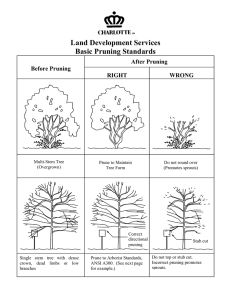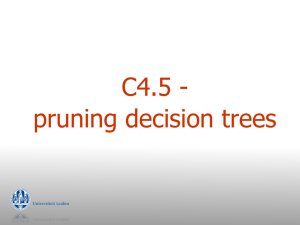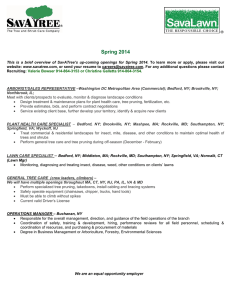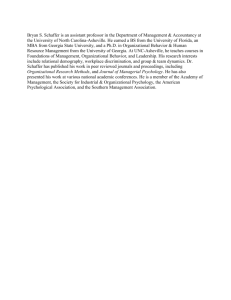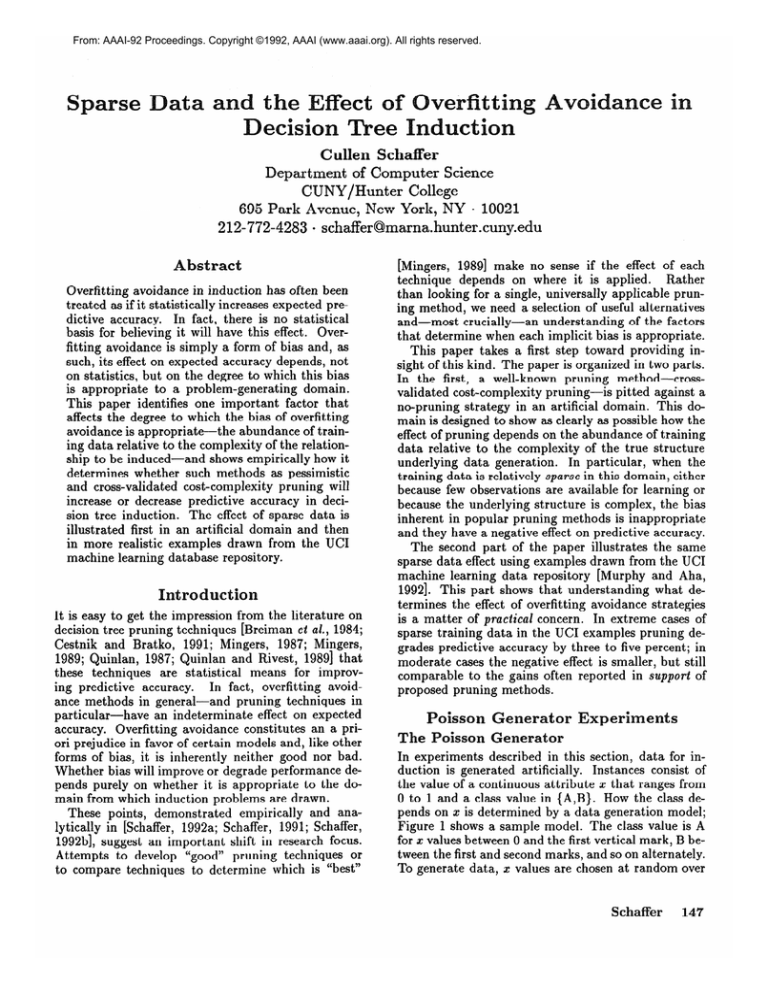
From: AAAI-92 Proceedings. Copyright ©1992, AAAI (www.aaai.org). All rights reserved.
Cullen Schaffer
Department of Computer Science
CUNY/Hunter
College
10021
695 Park Avenue, New York, NY
212-7’72-4283
schaffer@marna.hunter.cuny.edu
l
l
Abstract
Overfitting avoidance in induction has often been
treated as if it statistically increases expected predictive accuracy. In fact, there is no statistical
basis for believing it will have this effect. Overfitting avoidance is simply a form of bias and, as
such, its effect on expected accuracy depends, not
on statistics, but on the degree to which this bias
is appropriate to a problem-generating domain.
This paper identifies one important factor that
affects the degree to which the bias of overfitting
avoidance is appropriate-the
abundance of training data relative to the complexity of the relationship to be induced-and
shows empirically how it
determines whether such methods as pessimistic
and cross-validated cost-complexity pruning will
increase or decrease predictive accuracy in decision tree induction. The effect of sparse data is
illustrated first in an artificial domain and then
in more realistic examples drawn from the UCI
machine learning database repository.
Introduction
It is easy to get the impression from the literature on
decision tree pruning techniques [Breiman e2 al., 1984;
Cestnik and Bratko, 1991; Mingers, 1987; Mingers,
1989; Quinlan, 1987; Quinlan and Rivest, 19891 that
these techniques are statistical means for improvIn fact, overfitting avoiding predictive accuracy.
ance methods in general-and
pruning techniques in
particular-have
an indeterminate effect on expected
accuracy. Overfitting avoidance constitutes an a priori prejudice in favor of certain models and, like other
forms of bias, it is inherently neither good nor bad.
Whether bias will improve or degrade performance depends purely on whether it is appropriate to the domain from which induction problems are drawn.
These points, demonstrated empirically and analytically in [Schaffer, 1992a; Schaffer, 1991; Schaffer,
1992b], suggest an important shift in research focus.
Attempts to develop “good” pruning techniques or
to compare techniques to determine which is “best”
[Mingers, 19891 make no sense if the effect of each
technique depends on where it is applied.
Rather
than looking for a single, universally applicable pruning method, we need a selection of useful alternatives
and-most
crucially-an
understanding of the factors
that determine when each implicit bias is appropriate.
This paper takes a first step toward providing insight of this kind. The paper is organized in two parts.
In the first, a well-known pruning method-crossvalidated cost-complexity pruning-is pitted against a
no-pruning strategy in an artificial domain. This domain is designed to show as clearly as possible how the
effect of pruning depends on the abundance of training
data relative to the complexity of the true structure
underlying data generation. In particular, when the
training data is relatively sparse in this domain, either
because few observations are available for learning or
because the underlying structure is complex, the bias
inherent in popular pruning methods is inappropriate
and they have a negative effect on predictive accuracy.
The second part of the paper illustrates the same
sparse data effect using examples drawn from the UC1
machine learning data repository [Murphy and Aha,
19921. This part shows that understanding what determines the effect of overfitting avoidance strategies
is a matter of practical concern. In extreme cases of
sparse training data in the UC1 examples pruning degrades predictive accuracy by three to five percent; in
moderate cases the negative effect is smaller, but still
comparable to the gains often reported in support of
proposed pruning methods.
oisson
The
Poisson
Generator
Experiments
Generator
In experiments described in this section, data for induction is generated artificially. Instances consist of
the value of a continuous attribute x that ranges from
0 to 1 and a class value in (A,B}. How the class depends on z is determined by a data generation model;
Figure 1 shows a sample model. The class value is A
for x values between 0 and the first vertical mark, B between the first and second marks, and so on alternately.
To generate data, x values are chosen at random over
Schaffer
147
a
A
0
A
B
B
X
*
1
Figure 1: A sample data generation model
the interval [O,l] and paired with the associated class
values. Then, to simulate the effect of classification
noise, class values are complemented with probability
e.
The data generator creates a new data generation
model each time it is called and then uses this model
to produce training and test data. Models vary only
in the number and placement of the vertical cutpoints,
which are determined according to a Poisson process
with parameter X. That is, the number of cutpoints is
chosen at random over { 0,1,2,. . . } , the expected number of cutpoints is X, and, once the number is chosen,
cutpoints are placed at random in the interval [O,l].
The value of A is a parameter of the data generator set
by the user.
Since the number of cutpoints in a model is one less
than the number of leaves in the corresponding optimal
decision tree, X is a measure of the expected complexity
of the underlying model. The Poisson generator just
described thus provides a way to generate induction
problems at varying levels of complexity. By paring
induction down to essentials-one
attribute and two
classes-the generator helps to focus attention on the
effect of sparse data. Complex examples representative
of induction in real application domains are discussed
in below.
Algorithms
for Comparison
Two tree induction algorithms are compared in these
experiments, each implemented by choosing appropriate options of the CART program. CV uses the Gini
splitting criterion to build trees and cost-complexity
optimization through tenfold cross-validation to prune
them. It differs from the default version of CART
[Breiman et al., 19841 only in that (1) it replaces
the one-standard-error rule described in [Breiman et
al., 1984, p. 781 with a zero-standard-error rule that
has performed better in related experiments [Schaffer,
1992a] and (2) it allows nodes of any size to be split.
The default version of CART will not split nodes of
less than five training cases. A second algorithm, NP,
is identical to CV except that it does not carry out any
pruning.
Wypot hesis
The basic hypothesis underlying this paper is that the
effect of overfitting avoidance depends, among other
things, on the amount of training data relative to the
complexity of the data generation model. Under certain conditions, characteristic both of the artificial examples of this section and the real-data examples of
148
Learning: Inductive
the next, this factor may be critical. As we consider
increasingly complex models or smaller training sets
in such cases, pruning methods will, according to the
hypothesis, perform more and more poorly until, evenFor data
tually, they decrease predictive accuracy.
sufhciently sparse, in this sense, the bias inherent in
techniques like pessimistic and cross-validated costcomplexity pruning is inferior to the bias inherent in
a no-pruning strategy and we should expect the latter
to perform better.
Experimental
Methodology
To investigate this hypothesis, the algorithms CV and
NP were tested on problems produced by the Poisson
generator. Three parameters were varied in the course
of these tests: the size of the training set, n, the average model complexity, X, and the classification error
rate, e. For each of I68 combinations of n, A and e, the
three algorithms were tested on 50 problems produced
by the Poisson generator. In each case, a test set of
IO0 fresh instances was used to measure predictive accuracy. After 50 trials the overall accuracy of CV and
NP was compared.
Experimental
Results
The results of these experiments are summarized in
Figure 3. Each gridpoint is marked either with “CV,”
if that algorithm attained the highest overall predictive
accuracy for the associated n-X-e combination, or with
a dot (w) if NP is superior. 1 Note that the size of the
training set decreases along the vertical axis. As the
schematic diagram in Figure 2 indicates, this means
that data grows sparser in each grid as we move upward
or rightward.
These grids very neatly illustrate the sparse data effect: In each, pruned trees prove more predictive at the
lower left and unpruned trees more predictive at the
upper right. At the top and right, where data is sparsest, avoidance of overfitting through pruning degrades
performance, as predicted, rather than improving it.
In each grid, a downward sloping boundary separates a domain region in which the biases of the tested
pruning methods are appropriate from one in which
they are inappropriate. Note that the increasing levels
of noise have the effect of moving this boundary upward and to the right. Other things being equal, in
this domain, noise increases the value of pruning.
Additional experiments have been carried out by the
author for an induction strategy using information gain
and pessimistic pruning and by Ross Quinlan [personal
communication] for C4.5 with qualitatively similar results.
‘At one gridp oint a dash I-) indicates that these algorithms performed identically.
Accuracy
Leaves
5:
CV
3.8
10.2
NP
71.38
CV
70.40
NP
-.97A
Signif.
.12
Table 1: Results for heart disease data experiments
Examples
Figure 2: Schematic guide to the Poisson generator
results
from the UC1 Repository
In this section, examples drawn from the UC1 repository of machine learning databases are used to illustrate the sparse data effect.2 Except where noted, results are averaged over 50 trials in which training data
is selected at random and remaining data is used for
testing.
Cleveland Heart Disease Data
e = .05
.l
e=
n
n
20
20 * .
30 cv *
40 cv *
50 cv cv
60
cv
cv
70
cv
cv
4
6
.
.
30 cv cv
40 cv cv
50 cv cv
cv
8
cv
cv
.
60
cv
cv
cv
cv
.
.
.
70
cv
cv
cv
cv
cv
.
.
4
6
8
.2
.
.
.
.
f
60
cv
cv
*
cv
cv
cv
cv
*
cv
cv
8
.
n
20
cv
.
cv
.
-
cv
*
.
50 cv cv cv cv cv
.
.
-
60
.
.
*
.
CV
CV
CV
70 cv cv cv
4
6
8
.
. cv
.
.
30 cv cv cv .
40 . . .cv.
10 12 14 16
x
.3
e=
cv
6
10 12 14 16
A
cv
4
.
.
*
.
20 . 30 cv cv
40 cv cv
50 cv cv
70 cv cv
.
.
.
-
*
n
cv
.
.
x
cv
.
cv
10 12 14 16
e=
.
* . .
* . .
* cv cv
.
. cv
.
.
10 12 14 16
x
Figure 3: Results for the Poisson generator experiments
Table 1 summarizes the results of experiments with
the Cleveland heart disease data.3 With real data of
this kind, we have no control over the complexity of
the true relationship governing data generation, but
we can investigate the effect of sparse data by incrementally decreasing the size of the training set. The
table shows that, as we do, the predictive accuracy of
trees produced by NP climbs from about one percent
below those produced by CV to more than three percent above. As in the artificial domain, the effect of
overfitting avoidance is negative for sufficiently sparse
training data.
The last column of the table gives the statistical significance of NP’s superiority, according to a paired t
test; in the higher rows, this figure may be subtracted
from 1 to get the significance of CV’s superiority instead. A figure near .5 in the last column would indicate that there is no statistically significant difference
between the algorithms.
Similar results have been obtained for the Cleveland
heart disease data in experiments comparing PS, an
IND-based [Buntine and Caruana, 19911 tree induction strategy using information gain to build trees and
Quinlan’s pessimistic method [Quinlan, 19871 to prune
them, with PS-NP, a strategy that builds trees the
same way, but does not prune.
2All data is available by anonymous FTP from the directory pub/machine-learning-databases
at ics.uci.edu.
3CART requires training sets to include at least one representative of each class for each fold of cross-validation.
Thus, even if a full training set includes such representatives and NP produces a tree as usual, CART may refuse
to produce a tree using the options defining CV. Cases of
this hind are excluded from the analysis in this section. All
statements that one of NP or CV is superior to the other
ought, for precision, to be prefaced by the phrase “when
both algorithms produce trees.. .”
Schaffer
149
I
300:
2000
1000
500
250
125
Leaves
I
CV
NP
CV
608.0
659.5 74.34
430.5
489.9
70.60
258.6
296.8 63.00
142.1
176.3 54.79
77.4
105.2 44.03
62.6
32.57
45.9
I
Accuracv
NP
=A Signif.
-.14
<.01
74.20
70.58
-.02
.37
63.06
.06
.76
55.06
.94
.27
44.32
.98
.29
33.95
1.38
.96
n
1600
400
100
20
10
Leaves
CV
NP
6.5
7.5
3.8
5.4
2.3
3.2
2.0
2.2
1.9
2.1
CV
99.86
99.35
97.94
90.70
76.86
Accuracy
A
NP
99.92
.06
99.47
.13
98.21
.27
90.73
.03
82.28
5.42
Signif.
>.99
.99
>.99
.55
>.99
Table 3: Results for mushroom data experiments
Table 2:
ments
Letter
Results for letter recognition
data experiLeaves
ecognition
Data
The Cleveland heart disease data illustrates the fact
that NP may be superior when training sets are sufficiently small. But training data may be sparse, in
the sense of this paper, even for large training sets if
the true relationship between attributes and classes is
sufficiently complex. Results for the letter recognition
data, shown in Table 2, are a case in point. This is a
second clear example of the sparse data effect in real
data, but, here, NP remains superior for training sets
of up to 1,000 cases. The complexity of the true underlying relationship is reflected by the enormous, but
highly predictive, trees constructed by both algorithms
given large amounts of training data.
In experiments with PS and PS-NP, the latter
proved superior for the letter recognition data for training sets of up to 16,000 cases. This would appear to
confirm past suggestions that the pessimistic method
may lead to consistent overpruning [Mingers, 19891.
igit Recognition
Data
A third example of the sparse data effect is reported in
a study of the digit recognition problem in [Schaffer,
1992a]. In that paper, CV is superior to NP by about
one percentage point when the training set contains
200 instances and attribute errors occur with probability .2. When the number of instances is cut to
100, however, NP proves superior by roughly an equal
amount, and its advantage rises to about three percentage points for training sets of size 25.
Mushroom
Data
Results for the mushroom data are more complex. An
initial set of experiments, summarized in Table 3, show
NP superior to CV at every tested training set size, but
with a deep dip in significance near n = 20.4 Given
training sets of this size, both CV and NP normally
discover the single attribute that accounts for about
90 percent of potential predictive accuracy and neither
regularly discovers anything else of use. For smaller
4At this level of n, an additional 150 trials were run to
confirm the weak significance. The table shows results for
a total of 200 trials.
150
Learning: Inductive
20;
100
60
30
20
15
10
cv
98.34
97.56
96.78
93.23
89.85
85.97
75.27
Act uracy
NP a
97.90 -.44
96.91
-.65
95.71
-1.07
92.20
-1.03
-.30
89.55
1.52
87.49
4.95
80.21
1
1
Table 4: Results for mushroom data with added noise
training sets, NP discovers the single, highly predictive
attribute more consistently, and for larger training sets
it leads the way in discovering additional predictive
structure; in both cases, it proves superior to CV.
A salient feature of the mushroom data is the low
level of noise evidenced by the extremely high accuracies achieved by both tested algorithms. Recalling the
effect of classification noise in the artificial domain of
the previous section, we may hypothesize that this lack
of noise is what allows NP to maintain its superiority
at every tested level of n. Table 4 confirms this hypothesis by showing the results of additional experiments
with the mushroom data in which artificial noise complements the class variable with probability .Ol. With
this modification, we again observe a clear example of
the sparse data effect.
Results of experiments with PS and PS-NP were
qualitatively much like those reported here. For the
original mushroom data, PS-NP proved superior for
training sets of 10 to 6,400 cases except for a middle
range centered about training sets of 40 cases. With
added classification noise, a clear sparse data effect was
observed, with the crossover near n = 25.
Hypothyroid
Data
Results for the hypothyroid data are the least clear of
those reported here. In initial experiments comparing
PS and PS-NP, this data seemed to yield another clear
example of the sparse data effect, as shown in Table 5.
For still larger training sets, however, the superiority of
PS’s pessimistic pruning decreased as both algorithms
converged to near perfect performance.
Moreover, experiments comparing CV and NP show
n
375
260
180
90
45
PS
5.5
5.5
5.2
3.4
1.8
Leaves
PS-NP
10.1
9.0
7.4
6.4
4.6
PS
98.4
97.7
97.3
95.2
93.1
Accuracy
A
PS-NP
98.2
-.2
97.7
0
97.4
.l
95.6
.4
94.1
1.0
Table 5: Results for hypothyroid
with PS and PS-NP
I
200:
375
260
180
90
45
Leaves
CV
NP
6.3
9.8
4.5
5.8
4.0
5.6
2.8
4.9
2.1
3.9
1.6
3.2
CV
99.79
98.56
97.57
96.24
95.41
94.83
Signif.
.02
.50
.91
.98
>.99
data experiments
Accuracy
A
NP
99.77
-.02
98.76
.20
97.79
.22
96.96
.72
95.46
.06
94.62
-.21
Table 7: Results for balanced two-class hypothyroid
data experiments with CV and NP
cient to run these trials.
Signif.
.19
>.99
.99
>.99
.62
c.01
Table 6: Results for two-class hypothyroid data experiments with CV and NP
the former superior for training sets of 45 cases-just
where pruning performed worst in experiments with PS
and PS-NP. Results for these experiments are shown
in Table 6. Note though, that these are not directly
comparable with results for PS and PS-NP. First, the
PS algorithms use information gain as a splitting criterion, while the CV algorithms use Gini. Second, for
practical reasons, the three positive classes of the hypothyroid data were merged for experiments with CV
and NP.5 Note also that 1,000 trials were run for n = 45
instead of the usual 50 in order to produce a clearer
result.
One fact that may account for the difference between
experiments with the hypothyroid data and the others
reported in this paper is that the class distribution for
the hypothyroid data is highly unequal. Negative cases
account for about 95 percent of the data. In a last set
of experiments, balanced data sets were constructed for
each trial using all of the positive cases and an equal
number of randomly selected negative cases. Data sets
constructed in this manner were split into training and
testing portions at random, as usual. Because the size
of the test sets was normally quite small, 100 trials
were run at each training set size.
The results, given in Table 7, show a uniform pattern, with NP superior at every tested training set size.
It would be interesting to know if CV is superior for
larger training sets, yielding a complete example of the
sparse data effect, but the data available is not suffi5See footnote 3. Some of the positive classes are so
weakly represented that they are almost certain not to ap
pear in one of the training sets used for cross-validation
and this causes the CART system to refuse to build a tree.
iscussion
The results of the previous section mainly speak for
themselves, but two points may be worth adding.
First, it was remarkably easy to find examples like the
mushroom and letter recognition data for which pruning degrades performance even for large training sets.
Data sets were selected for testing more or less at random from the UC1 repository and results for all but
one of those data sets have been reported here.6 Thus,
there is reason to suspect that the sparse data effect is
often of practical importance in the induction problems
considered by machine learning researchers.
Second, results for the hypothyroid data point up the
fact that sparsity of data is only one of several conditions which together determine the effect of overfitting
avoidance. In particular, if class prevalences are far
from equal, any of the well-known pruning methods
may increase predictive accuracy even when training
data is sparse.7
As argued in the introduction, when we recognize
that overfitting avoidance is a form of bias, we naturally turn our attention away from pursuing “good”
overfitting avoidance methods and toward a determination of where alternative methods are appropriate.
This paper contributes by identifying the abundance
of training data relative to the complexity of a target
relationship as one important factor in this determination. It stops far short, however, of defining sparsity
precisely or of telling us just how sparse data must
be for particular pruning methods to degrade performance. This is an important area for future work.
One thing that may be stated emphatically even at
this early juncture, however, is that it is hopeless to
6Results for the hepatitis data are omitted.
In that
case, there appears to be very little relationship between
attributes and classes. A one-node tree is almost optimally
predictive and, as might be expected when the the complexity of the target concept is so low, pruned trees are
superior even for very small training sets.
‘Ross Quinlan [personal communication] has produced
a variant version of the Poisson generator which divides
the unit interval as usual, but then assigns classes to the
subintervals with unequal probabilities. In this case, pruning uniformly increases the performance of (24.5.
Schaffer
151
expect the training data itself to tell us whether it
is sparse enough to make unpruned trees preferable.
As argued at length in [Schaffer, 1992131,training data
cannot tell us what bias is appropriate to use in interpreting it. In particular, the sparsity of data depends
on the complexity of the true relationship underlying
data generation; and it is not data but domain knowledge that can tell us how complex a relationship to
expect.
Acknowledgements
Special thanks to Ross Quinlan for his efforts to replicate the results reported here and for pointing out important flaws in a draft version of the paper. Thanks
also to Wray Buntine and Robert Holte for supporting
the ideas advanced here.
eferences
Breiman, Leo; Friedman, Jerome; Olshen, Richard;
and Stone, Charles 1984. Classification and Regression Trees. Wadsworth & Brooks, Pacific Grove, California.
Buntine, Wray and Caruana, Rich 1991. Introduction
to IND and recursive partitioning. Technical Report
FIA-91-28, RIACS and NASA Ames Research Center,
Moffett Field, CA.
Cestnik, Bojan and Bratko, Ivan 1991. On estimating
probabilities in tree pruning. In Machine Learning,
EWSL-91.
Springer-Verlag.
Mingers, John 1987. Expert systems - rule induction with statistical data. Journal of the Operationad
Research
Society
38:39-47.
Mingers, John 1989. An empirical comparison of
pruning methods for decision tree induction. Machine
Learning
4(2):227-243.
Murphy, P. M. and Aha, D. W. 1992. UCI repository
of machine learning databases [a machine-readable
data repository]. Maintained at the Department of
Information and Computer Science, University of California, Irvine, CA.
Quinlan, J. Ross and Rivest, Ronald L. 1989. Inferring decision trees using the minimum description length principle. Information
and Computation
801227-248.
Quinlan, J. Ross 1987. Simplifying decision trees. International Journal of Man-Machine
Studies 27:221234.
Schaffer, Cullen 1991. When does overfitting decrease
prediction accuracy in induced decision trees and rule
sets?
In Machine Learning,
E WSL-91. SpringerVerlag.
Deconstructing the digit
Schaffer, Cullen 1992a.
recognition problem. In Machine Learning: Proceedings of the Ninth
International
Morgan Kaufmann.
152
Learning: Hraductive
Conference
(ML92).
Schaffer, Cullen 199213. Overfitting avoidance as bias.
Machine
Learning.


